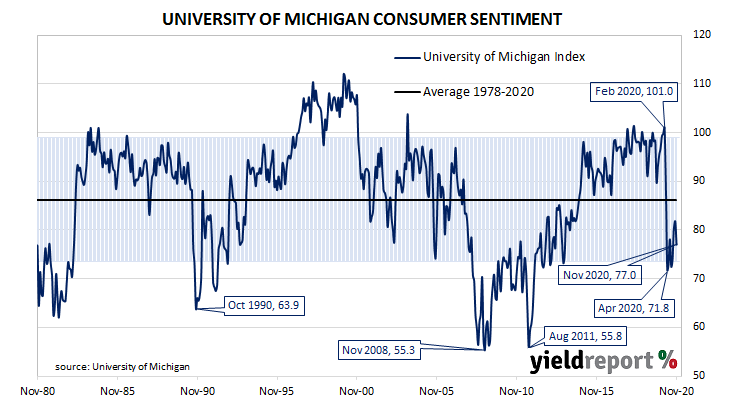Summary: US consumer confidence down in November; University of Michigan index lower than expected; future economic prospects viewed less favourably; decline due to election outcome, resurgence in COVID infections and deaths.
US consumer confidence started 2020 at an elevated level. However, by March, surveys had begun to reflect a growing uneasiness with the global spread of COVID-19 and its reach into the US. After a plunge in April, US household confidence began to recover, albeit in a haphazard fashion.
The latest survey conducted by the University of Michigan indicates the average confidence level of US households deteriorated in November, maintaining its somewhat-erratic trend. The University’s preliminary reading from its Index of Consumer Sentiment registered 77.0, noticeably less than the generally expected figure of 82.0 and lower than October’s final figure of 81.8.
“Consumer sentiment fell in early November as consumers judged future economic prospects less favourably, while their assessments of current economic conditions remained largely unchanged,” said the University’s Surveys of Consumers chief economist, Richard Curtin.

The report was released on the same day as October producer price indices and US Treasury bond yields moved slightly higher across the curve. By the end of the day, 2-year, 10-year and 30-year Treasury yields all finished 1bp higher at 0.18%, 0.89% and 1.65% respectively.
Curtin attributed the decline to the “outcome of the presidential election as well as the resurgence in COVID infections and deaths”. Republican supporters recorded “a substantial negative shift” in their future economic prospects.
Less-confident households are generally inclined to spend less and save more; some drop-off in household spending could be expected to follow. As private consumption expenditures account for a majority of GDP in advanced economies, a lower rate of household spending growth would flow through to lower GDP growth if other GDP components did not compensate.

